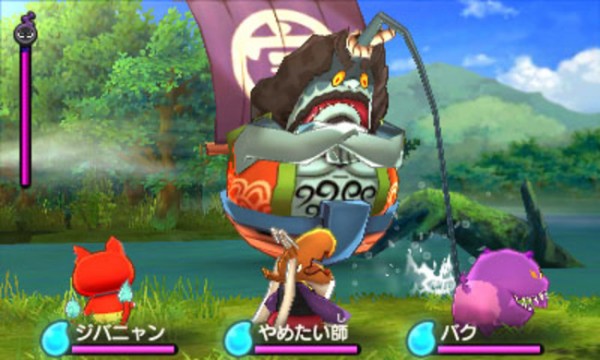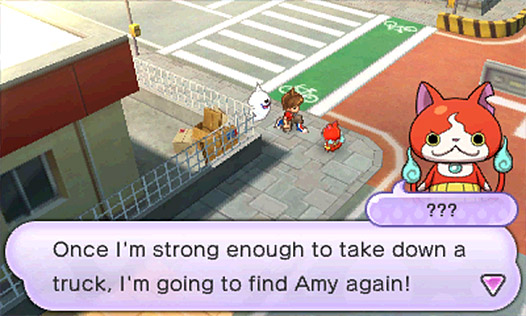Charming and humorous translation; Large amount of content; Rewarding side quests; Battle system is fun...
...but the battle system isn't very deep; Not a lot of incentive to befriend every Yo-Kai; RPG vets will find it too easy
Since making its debut in Japan, Yo-Kai Watch has become a bit of a cultural phenomenon. Naturally, many gamers in the west took notice, wondering whether characters like Jibanyan and Whisper would find similar popularity in other territories. Now the game has finally reached our shores, and it’s safe to say that, regardless of whether or not it finds the same level of commercial success, the title manages to deliver a fun experience that lives up to the hype.
Yo-Kai Watch follows the story of a young boy or girl that discovers a watch that enables the user to see Yo-Kai (ghosts). The title is broken up into smaller chapters in which the main character and a Yo-Kai named Whisper are tasked with helping people solve problems that have been, in most cases, caused by an unseen Yo-Kai. Each chapter is loosely connected by a larger narrative, almost like a television series. As a result, the storyline is a bit smaller in scale than other titles in the RPG genre, but the story really shines in its sense of humor. The game’s writing is very strong, and it’s obvious that the translation team had quite a fun time with it. There are also a few subtle references to the Ghostbusters films, which was a neat touch given the subject matter.
The game takes place in Springdale, a world heavily modeled after Japan. As the player completes more chapters, more of the surrounding area is unlocked. The game helps players navigate with an arrow appearing on the lower screen’s map, showing them where to go next. Younger players, and those without a lot of RPG experience, will have a much easier time navigating Springdale as a result. While the arrows are a big help, they can also be a source of frustration, too. Unfortunately, sometimes the game’s next location can’t be accessed until the Yo-Kai Watch is upgraded to its next level. Doing so often requires a bit of a fetch quest, and the arrow never resets itself to indicate that. The arrow might be pointing to the museum, but that area can’t be entered until the Yo-Kai Watch reaches a certain lettered rank, and doing that requires finding particular Yo-Kai. It’s a small qualm, but it can be frustrating.

The game’s most controversial feature seems to be the battle system. Players keep a party of six Yo-Kai on hand, with three in battle at once. The Yo-Kai are positioned on a dial, which can be rotated around to bring different Yo-Kai in. The three Yo-Kai on top automatically attack, with the player prompting stronger attacks when the character’s spirit meter fills. Yo-Kai on the bottom are free from attack, which means the player can rotate out injured Yo-Kai to heal them, or cure those that have been inspirited. Finally, grouping Yo-Kai of the same type next to one another boosts attack stats. The battles tend to be a bit on the easy side, but the pace is fast and entertaining.
Strangely, Yo-Kai Watch doesn’t make a strong enough effort to convince players to add more creatures to their collection. Enemy encounters aren’t random. In most areas, the player has to actively search for Yo-Kai, except in certain areas where they walk around in the field and can be avoided. The player doesn’t actually “catch” Yo-Kai; the ghosts will randomly decide to befriend the player after some battles. This is where the battle system’s simplicity really works against it. The Yo-Kai themselves are mostly well designed and cleverly named, but without a need to focus on type matching, or creating a balanced party, there isn’t a lot of incentive to seek out new Yo-Kai or change party members. That said, the game’s main mascots, Whisper and Jibanyan, are really endearing. The latter character’s backstory is both sad and dark, and it’s a pleasant surprise to see that it made it to the west intact.

Yo-Kai Watch is a great introductory RPG for younger players. The battle system (while fun) isn’t overly complex, and there are very few boss fights that will really challenge players. Veterans of the genre might scoff at the game’s simpler nature, but the amount of gameplay that Yo-Kai Watch offers helps to negate that critique. While players won’t have to grind too much, one nice touch in the game is that side quests are rewarded with experience points in addition to items. The game offers a plethora of side missions too, and with the game’s sense of humor, it’s a much more entertaining option than fighting the same Yo-Kai again and again. It would be great to see more RPGs adopt this.
The biggest detriment to Yo-Kai Watch is that it’s hard not to compare the game to Pokémon. There are certainly some similarities on the surface: both games have monsters that evolve, and the music that plays while you enter a store or ride a bike seems eerily similar. The mechanics of both games are much different, however. The battle system in Yo-Kai Watch is the biggest difference between the two games, and I found that I didn’t enjoy battles all that much until I convinced myself to stop comparing it to Nintendo’s monster-catching franchise. Another interesting difference, Yo-Kai Watch has quite a few ties to the game’s related anime series. While Nintendo has always kept the worlds of the Pokémon games and cartoon fairly separate, Yo-Kai Watch starts with an anime sequence, uses voice actors from the show, and even rewards players for completing side quests with bonus anime scenes. If Nintendo ever decides to remake Pokémon Yellow, it would be really nice to see the developers take a similar approach.
Yo-Kai Watch might not be Pokémon, but it doesn’t have to be. Level-5 and Nintendo have delivered a world filled with enough humor and charm that it stands more than well enough on its own. The game has some minor issues, but nothing is ever significant enough to trump what Yo-Kai Watch does so well. RPG veterans won’t find the journey all that difficult, but younger fans and the young at heart will find plenty to love.




 ShareThis
ShareThis






Spot-on review, man. People need to get their Yo-Kai on.
“Yo-Kai Watch is a great introductory RPG for younger players”
Couldn’t agree more!
On a related note, The Yo-Kai display at the current “Nintendo Mall Tour” was a nice surprise. There’s a little capsule toy dispenser next to the Yo-Kai display (full of temporary tattoos). Let’s just say Santa was only the second coolest thing at the mall this year according to my sons.
Too easy? I play rpgs since childhood and found the boss from the onsen veru very very hard! Come on, this game is hard dude ;_;